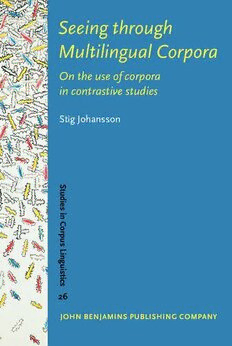
Seeing through Multilingual Corpora: On the use of corpora in contrastive studies PDF
Preview Seeing through Multilingual Corpora: On the use of corpora in contrastive studies
<DOCINFOAUTHOR""TITLE"SeeingthroughMultilingualCorpora:Ontheuseofcorporaincontrastivestudies"SUBJECT"StudiesinCorpusLinguistics,Volume26"KEYWORDS""SIZEHEIGHT"240"WIDTH"160"VOFFSET"4"> SeeingthroughMultilingualCorpora StudiesinCorpusLinguistics SCLfocusesontheuseofcorporathroughoutlanguagestudy,the developmentofaquantitativeapproachtolinguistics,thedesignanduseof newtoolsforprocessinglanguagetexts,andthetheoreticalimplicationsofa data-richdiscipline. GeneralEditor ElenaTognini-Bonelli ConsultingEditor WolfgangTeubert AdvisoryBoard MichaelBarlow GeoffreyLeech UniversityofAuckland UniversityofLancaster RobertdeBeaugrande AnnaMauranen UniversitàdelLitorale,Capodistria UniversityofHelsinki DouglasBiber UteRömer NorthArizonaUniversity UniversityofHannover ChrisButler JohnSinclair UniversityofWales,Swansea TheTuscanWordCentre SylvianeGranger PietvanSterkenburg UniversityofLouvain InstituteforDutchLexicology,Leiden M.A.K.Halliday JanSvartvik UniversityofSydney UniversityofLund SusanHunston JohnSwales UniversityofBirmingham UniversityofMichigan StigJohansson H-Z.Yang OsloUniversity JiaoTongUniversity,Shanghai GraemeKennedy VictoriaUniversityofWellington Volume26 SeeingthroughMultilingualCorpora Ontheuseofcorporaincontrastivestudies byStigJohansson Seeing through Multilingual Corpora On the use of corpora in contrastive studies Stig Johansson UniversityofOslo JohnBenjaminsPublishingCompany Amsterdam(cid:2)/(cid:2)Philadelphia TM Thepaperusedinthispublicationmeetstheminimumrequirements 8 ofAmericanNationalStandardforInformationSciences–Permanence ofPaperforPrintedLibraryMaterials,ansiz39.48-1984. CoverillustrationfromoriginalpaintingRandomOrder byLorenzoPezzatini,Florence,1996. LibraryofCongressCataloging-in-PublicationData Johansson,Stig,1939- Seeingthroughmultilingualcorpora:ontheuseofcorporaincontrastive studies/ StigJohansson. p. cm.(StudiesinCorpusLinguistics,issn1388–0373;v.26) Includesbibliographicalreferencesandindexes. 1.Contrastivelinguistics.2.Translatingandinterpreting.3.Corpora (Linguistics).I.Title. P134.J63 2007 410--dc22 2006048039 isbn9789027223005(Hb;alk.paper) ©2007–JohnBenjaminsB.V. Nopartofthisbookmaybereproducedinanyform,byprint,photoprint,microfilm,or anyothermeans,withoutwrittenpermissionfromthepublisher. JohnBenjaminsPublishingCo.·P.O.Box36224·1020meAmsterdam·TheNetherlands JohnBenjaminsNorthAmerica·P.O.Box27519·Philadelphiapa19118-0519·usa Table of contents Preface xiii Acknowledgements xv Listoffigures xvii Listoftables xix Listofabbreviations xxi chapter1 Thecaseforcorporaincontrastivestudies 1 1.1 Seeingthroughcorpora 1 1.2 Contrastiveanalysis 1 1.3 Theproblemofequivalence 3 1.4 Translationstudies 4 1.5 Acorpus-basedapproach 4 1.6 Translationcorporavs.comparablecorpora 5 1.7 Correspondencevs.equivalence 5 1.8 Structurevs.use 6 1.9 Usesofmultilingualcorpora 6 1.10 Anoteonexamplesandreferences 7 chapter2 Buildingamultilingualcorpus 9 2.1 Corpusmodels 9 2.1.1 Translationcorpora 9 2.1.2 Comparablecorpora 10 2.2 BuildingtheEnglish-NorwegianParallelCorpus 10 2.2.1 TheENPCmodel 11 2.2.2 Textselection 12 2.2.3 Textencoding 14 2.2.4 Alignment 14 2.2.5 Tagging 16 2.2.6 Searchtools 17 2.3 TheOsloMultilingualCorpus 18 2.4 Aparalleltranslationcorpus 19 SeeingthroughMultilingualCorpora 2.5 Amultipletranslationcorpus 20 2.6 Thechoiceofacorpusmodel 21 chapter3 Usingmultilingualcorpora 23 3.1 Translationparadigms 23 3.2 Divergentcorrespondences 25 3.3 Zerocorrespondence 26 3.4 Mutualcorrespondence 26 3.5 Semanticreflections 29 3.6 Paralleltranslations 31 3.7 Translationeffects 32 3.8 Combiningcomparableandtranslationcorpora 33 3.9 Contrastinglexis 35 3.10 Contrastingsyntaxanddiscourse 37 3.11 Researchquestions 38 3.12 Linguisticinterpretation 39 chapter4 Contrastingnouns:Timesoftheday,mind,person,thing,fact 41 4.1 Introduction 41 4.2 Timesoftheday 41 4.2.1 Englishnoon 42 4.2.2 Norwegianformiddag andettermiddag 43 4.2.3 Englishnight 44 4.2.4 Norwegiandøgn 46 4.2.5 Summingup:Timesofthedayintranslation 47 4.3 Whatdoyouhaveinmind? 48 4.3.1 Correspondencesofmind 49 4.3.2 Summingup:Mindinacross-linguisticperspective 51 4.4 Whatisaperson? 53 4.4.1 Englishcorrespondencesofmenneske 53 4.4.2 PersoninEnglishvs.Norwegian 57 4.4.3 Menneskevs.person 64 4.4.4 Summingup:Personinacross-linguisticperspective 67 4.5 Whatisathing? 68 4.5.1 Congruentcorrespondences 70 4.5.2 Divergentcorrespondences 74 4.5.3 Summingup:Thinginacross-linguisticperspective 77 Tableofcontents 4.6 Isthatafact? 78 4.6.1 Thefact +that-clause 79 4.6.2 Infact 85 4.6.3 Summingup:Fact inacross-linguisticperspective 90 4.7 Summingup:Contrastingnouns 92 chapter5 LovingandhatinginEnglishandNorwegian 95 5.1 Introduction 95 5.2 Overalldistribution 96 5.3 Overalltranslationpatterns 96 5.4 TranslationsofEhate 98 5.4.1 Complementclauses 98 5.4.2 Othernon-personalobjects 98 5.4.3 Personalobjects 99 5.5 TranslationsofElove 100 5.5.1 Complementclauses 100 5.5.2 Othernon-personalobjects 100 5.5.3 Personalobjects 101 5.6 Summingup:Lovingandhatingincross-linguisticperspective 102 chapter6 SpendingtimeinEnglish,Norwegian,andGerman 107 6.1 Introduction 107 6.2 Overviewofresults 107 6.3 Congruenttranslations 109 6.4 Restructuring 110 6.5 Distributioninoriginalandtranslatedtexts 113 6.6 Anoteonsourcesofspend 114 6.7 Summingup:Spendacross-linguisticperspective 115 chapter7 TheEnglishverbseemanditscorrespondencesinNorwegian: Whatseemstobetheproblem? 117 7.1 Introduction 117 7.2 Somecharacteristicsofseem 117 7.3 Material:Overalldistribution 118 7.4 Overviewofcorrespondences 119 7.5 Typesofdivergentcorrespondences 120 7.6 Acloserlookatsometypesofcorrespondences 123 7.6.1 Lexicalverbsandtheirpatterns 124 SeeingthroughMultilingualCorpora 7.6.2 Modalparticles 130 7.6.3 Zerocorrespondence 132 7.7 Conclusion 137 chapter8 SomeaspectsofusualityinEnglishandNorwegian 139 8.1 Introduction 139 8.2 Materialandmethod 139 8.3 Thedet+hendeconstructionanditscorrespondencesinEnglish 140 8.3.1 Frequencyadverbial 140 8.3.2 Frequencyadverbial+modalauxiliary 141 8.3.3 Modalauxiliary 142 8.3.4 Lexicalverb 143 8.3.5 Othercorrespondences 146 8.3.6 Thedet+hendeconstruction:Summingup 146 8.3.7 Anoteondet+hendeconstructionsexpanded bymodalauxiliaries 147 8.4 Theit+happenconstructionanditscorrespondencesin Norwegian 148 8.5 Usesoftheit+happenconstruction 149 8.6 Interpretation 150 8.6.1 ContrastingEnglishandNorwegian 151 8.6.2 Thefunctionofhende/happenconstructions 151 8.7 Conclusion 153 chapter9 Insearchofthemissingnot:SomenotesonnegationinEnglish andNorwegian 155 9.1 Introduction 155 9.2 Overallfrequenciesofikkeandnot 156 9.3 EnglishcorrespondencesofNorwegianikke 157 9.3.1 No-negation 157 9.3.2 Affixalnegation 162 9.3.3 Othercorrespondences 163 9.4 NorwegiancorrespondencesofEnglishnot 168 9.4.1 Syntheticnegation 169 9.4.2 Affixalnegation 170 9.4.3 Othercorrespondences 170 9.5 Whynotnot? 173 Tableofcontents chapter10 ThegenericpersoninEnglish,German,andNorwegian 175 10.1 Introduction 175 10.2 Materialandmethod 175 10.3 Overview 176 10.3.1 Syntax 177 10.3.2 Overalldistribution:Englishone,German andNorwegianman 178 10.4 EnglishoneanditscorrespondencesinGermanandNorwegian 178 10.5 EnglishsourcesofNorwegianman 180 10.6 EnglishsourcesofGermanman 181 10.7 NorwegianparallelstoGermanman 183 10.8 Summingupthedifferences 185 10.9 Germanman+sehen 186 10.9.1 Genericsensersubject 188 10.9.2 Specificsensersubject 188 10.9.3 Phenomenonassubject 189 10.9.4 Dummysubject 190 10.9.5 Nosubject 191 10.9.6 Nominal 191 10.9.7 Noperceptionprocess 191 10.9.8 Correspondencesofmanincombinationwithhören 192 10.9.9 Germanman+sehen:Discussion 193 10.10 AcomparisonwithSwedish 194 chapter11 Whychangethesubject?:Onchangesinsubjectselectionintranslation fromEnglishintoNorwegian 197 11.1 Aim 197 11.2 Themultiple-translationproject 197 11.3 Researchquestions 198 11.4 Characteristicsofthesubject 199 11.5 Overviewoffindings 199 11.6 Whatsortsofsubjectsarereplaced? 201 11.7 Wheredothenewsubjectscomefrom? 201 11.8 Discussionofchanges 202 11.8.1 Changestriggeredbylexis 203 11.8.2 Nominalizationsinsubjectposition 204 11.8.3 Insertionofdummydet 205 11.8.4 Changesinvoice 209 11.8.5 Subjectselectionandcohesion 212
